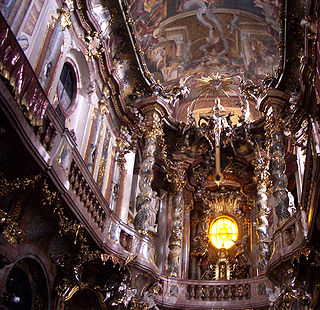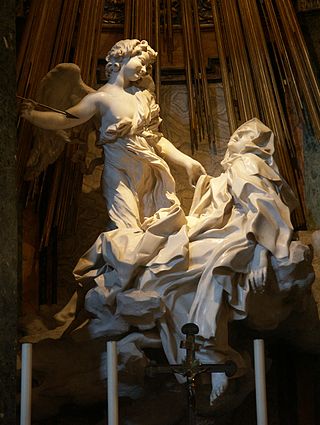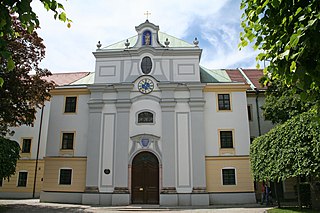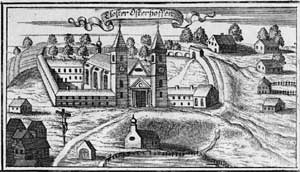
Cosmas Damian Asam was a German painter and architect during the late Baroque period. Born in Benediktbeuern, he lived in Rome from 1711 to 1713 to study at the Accademia di San Luca with Carlo Maratta. In 1713, Asam won the Academy's first prize for his drawing of Miracle of Saint Pio. In Germany, he worked with his brother Egid Quirin, a sculptor and stucco worker, on building and decorating entirely new churches or redesigning churches in the Baroque style. Their joint projects are often attributed to the "Asam Brothers". Cosmas Damian died in Munich.
The year 1746 in architecture involved some significant events.

Johann Michael Fischer was a German architect in the late Baroque period.

Břevnov Monastery is a Benedictine archabbey in the Břevnov district of Prague, Czech Republic. It was founded by Saint Adalbert, the second Bishop of Prague, in 993 AD with the support of Bohemian Duke Boleslaus II. The first Benedictine male monastery in Bohemia, it also has the oldest tradition of beer brewing in the Czech Republic. Brewing was interrupted several times in the history, but up to today, the Břevnov Monastery Brewery brew its beer here.

The Dominican Church, also known as the Church of St. Maria Rotunda, is an early Baroque parish church and minor basilica in the historic center of Vienna, Austria. It is the third church built on the same site in the course of time.

Freising Cathedral, also called Saint Mary and Corbinian Cathedral, is a romanesque basilica in Freising, Bavaria. It is the co-cathedral of the Catholic Archdiocese of Munich and Freising. Freising Cathedral is also known for being the place where Pope Benedict XVI was ordained a priest.

Egid Quirin Asam was a German plasterer, sculptor, architect, and painter. He was active during the Late Baroque and Rococo periods.

The Asam brothers were sculptors, painters, and architects, who worked mostly together and in southern Germany. They are among the most important representatives of the German late Baroque.

The Church of Saint-Merri or Église Saint-Merry) is a parish church in Paris, located near the Centre Pompidou along the rue Saint Martin, in the 4th arrondissement on the Rive Droite. It is dedicated to the 8th century abbot of Autun Abbey, Saint Mederic, who came to Paris on pilgrimage and later died there in the year 700. In 884 Mederic was declared patron saint of the Right Bank.

Baroque sculpture is the sculpture associated with the Baroque style of the period between the early 17th and mid 18th centuries. In Baroque sculpture, groups of figures assumed new importance, and there was a dynamic movement and energy of human forms—they spiralled around an empty central vortex, or reached outwards into the surrounding space. Baroque sculpture often had multiple ideal viewing angles, and reflected a general continuation of the Renaissance move away from the relief to sculpture created in the round, and designed to be placed in the middle of a large space—elaborate fountains such as Gian Lorenzo Bernini‘s Fontana dei Quattro Fiumi, or those in the Gardens of Versailles were a Baroque speciality. The Baroque style was perfectly suited to sculpture, with Bernini the dominating figure of the age in works such as The Ecstasy of St Theresa (1647–1652). Much Baroque sculpture added extra-sculptural elements, for example, concealed lighting, or water fountains, or fused sculpture and architecture to create a transformative experience for the viewer. Artists saw themselves as in the classical tradition, but admired Hellenistic and later Roman sculpture, rather than that of the more "Classical" periods as they are seen today.

Fürstenfeld Abbey is a former Cistercian monastery in Fürstenfeldbruck, Bavaria, Germany.

Matthäus Günther was an important German painter and artist of the Baroque and Rococo era.

The Mannheim Jesuit Church is a Catholic church of historic and artistic importance in Mannheim, Germany. Church construction was begun in 1733 and completed in 1760. It was consecrated to St. Ignatius of Loyola and St. Francis Xavier. During the Second World War, the church suffered severe damage from air attacks; after the war it was rebuilt in its historical style using original parts.

The Trinity Church is a religious building in Munich, southern Germany. It is a votive church and was designed in Bavarian Baroque style according to plans from Giovanni Antonio Viscardi from 1711 to 1718. It is a monastery church of the Carmelites and a church of the Metropolitan parish of Our Blessed Lady. During the Second World War this was the only church in the center of Munich, which had been spared from destruction by bombs.

Klosterkirche St. Anna im Lehel is a Catholic abbey church in Munich, Germany. It was the first Rococo church of Old Bavaria and shaped the development of religious architecture in Bavaria. It is located in the center of Lehel opposite to the neo-romanesque Catholic parish church of St. Anna im Lehel.

Innsbruck Cathedral, also known as the Cathedral of St. James, is an eighteenth-century Baroque cathedral of the Roman Catholic Diocese of Innsbruck in the city of Innsbruck, Austria, dedicated to the apostle Saint James, son of Zebedee. Based on designs by the architect Johann Jakob Herkomer, the cathedral was built between 1717 and 1724 on the site of a twelfth-century Romanesque church. The interior is enclosed by three domed vaults spanning the nave, and a dome with lantern above the chancel. With its lavish Baroque interior, executed in part by the Asam brothers, St. James is considered among the most important Baroque buildings in the Tyrol.

Osterhofen Abbey is a former monastery in Bavaria, Germany, It is located in the Altenmarkt section of Osterhofen, a town to the south of the Danube between Deggendorf and Vilshofen / Passau. It has its origins in a collegiate built in 1004–09. From 1128 to 1783 it was a Premonstratensian monastery. For a while it was then a convent. Today it contains a girls' secondary school. The former abbey church, a magnificent late baroque building erected in 1726–40, is now the Basilica of Saint Margaret.
Asam is a surname. Notable people with the surname include:

Sendlinger Straße is an important shopping street in Munich's city center. It extends into the Munich old town in the south-east-northeast direction from the Sendlinger Tor in the west to the point where Fürstenfelder Straße and the Rindermarkt meet in the east. In July 2016, the conversion from a one-way street into a pedestrian zone was attempted.

St. Joseph is a Rococo church in Starnberg, Bavaria, Germany. It was built in the second half of the 18th century. The high altar of the church was created by Ignaz Günther.




















